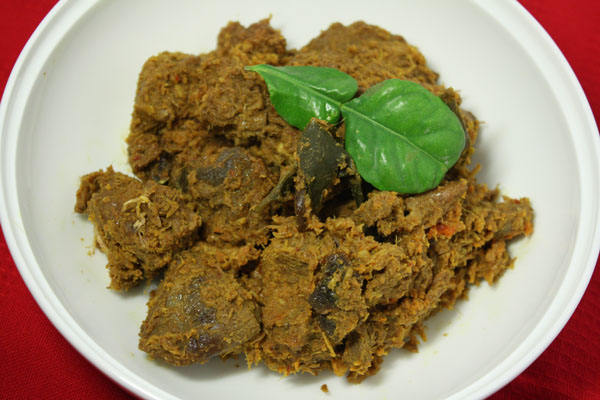I am definitely not a meat eater. I cannot even finish a piece of steak on my own but when it come to this one particular dish, I can just keep going and going and going and goinggggg….. Oh, especially if it’s the one cooked by my Maa-ji-dearest….
Apart from being a popular dish over the festive period of the Eid festivals (also known as Hari Raya) in Southeast Asia, I always look upon this dish as the ‘balik kampung’ (homecoming in Malay) dish, especially so, towards the end of Ramdahan / Eid period. For my family in particular, Beef Rendang is one dish we would have on the eve of Eid, together with the Ketupats (rice cakes) and such. Whenever i think of Rendang, I also think of the ‘Kampungs’ (Village areas) of Malaysia – yet another perception I created for myself growing up. It’s like each time I ‘Think Rendang, Think Kampung,’ Malaysia in particular.
Malaysians love their Rendang and eat it with almost everything, from Nasi Lemak to Nasi Kuning to Pulut Kuning. Of course not forgetting the Rendang that is served with Ketupat and Lontong over the festive period. Oh yummmmm… Just thinking about it, my mouth is watering already… Just like how it can be served many ways, Rendang can also be cooked many ways, of course with certain basic ingredients remaining the same, which makes Rendang, Rendang! Most of the time, the basic Ingredients like the Kaffir Lime Leaves, Tumeric Leaves, Lemon Grass, Galangal, Kerisik (toasted coconut) and Coconut Milk remains
When I say cooked many ways, I mean Rendang can be cooked in many different styles. While the basic ingredients being kept the same , others are being varied, either ommitted or incorporated. Some Rendang can be more spicy than the others, some have contain more coconut than others and some have a bit more spicy-fragrance to it – just some ways of variation on the Rendang Dish. Of course, Rendang works with different types of meat, beef, lamb or chicken. My favourite is but of course, Beef Rendang! 🙂
Of course, in the olden days, the traditional Rendang is a very aromatic dish and cooked for quite long hours over wood fire or little portable stoves, like in the Kampungs. These days, of course, most of us will just cook our Rendang in the comfort of our home, either on our gas or electric stoves, for quite long hours, depending on the type of meat that is being cooked. One thing for sure, even though the Rendang cooked in the comfort of our own homes is very delicious, there is just something about that Rendang cooked over wood fire, which just makes me go craazzyyyyyy! Maybe because of the wood fired fragrance somehow incorporated in to the dish during the cooking process 🙂 Time to look for a Kampung!
Ingredients
- 1 kg Beef
- 3 heaped tablespoons Kerisik toasted desiccated Coconut
- 8 Kaffir Lime Leaves
- 2 Tumeric Leaves
- 500 ml Coconut milk
- 2 pieces tamarind peel
- 4 tablespoons Palm Sugar / Brown Sugar
For the paste
- 12 Shallots
- 6-8 cloves Garlic
- 5 cm fresh Turmeric
- 5 cm fresh Ginger
- 3 stalks Lemongrass
- 3 cm Galangal
- 15 stalks dried Chilli deseeded and washed
Instructions
- Mix the paste and the coconut milk in a pot and continue stirring to a boil.
- Add in Kaffir Lime Leave and Tumeric Leaves.
- Add in beef and bring to a slow boil till meat is tender.
- Add in all Kerisik and all other ingredients to taste.
- Leave to simmer till the gravy thickens or almost dry.
- Serve with piping hot rice or rice cakes.
Notes
Ensure that paste and coconut milk are being constantly stirred as mixture comes to a boil to avoid Coconut Milk from being burnt.






